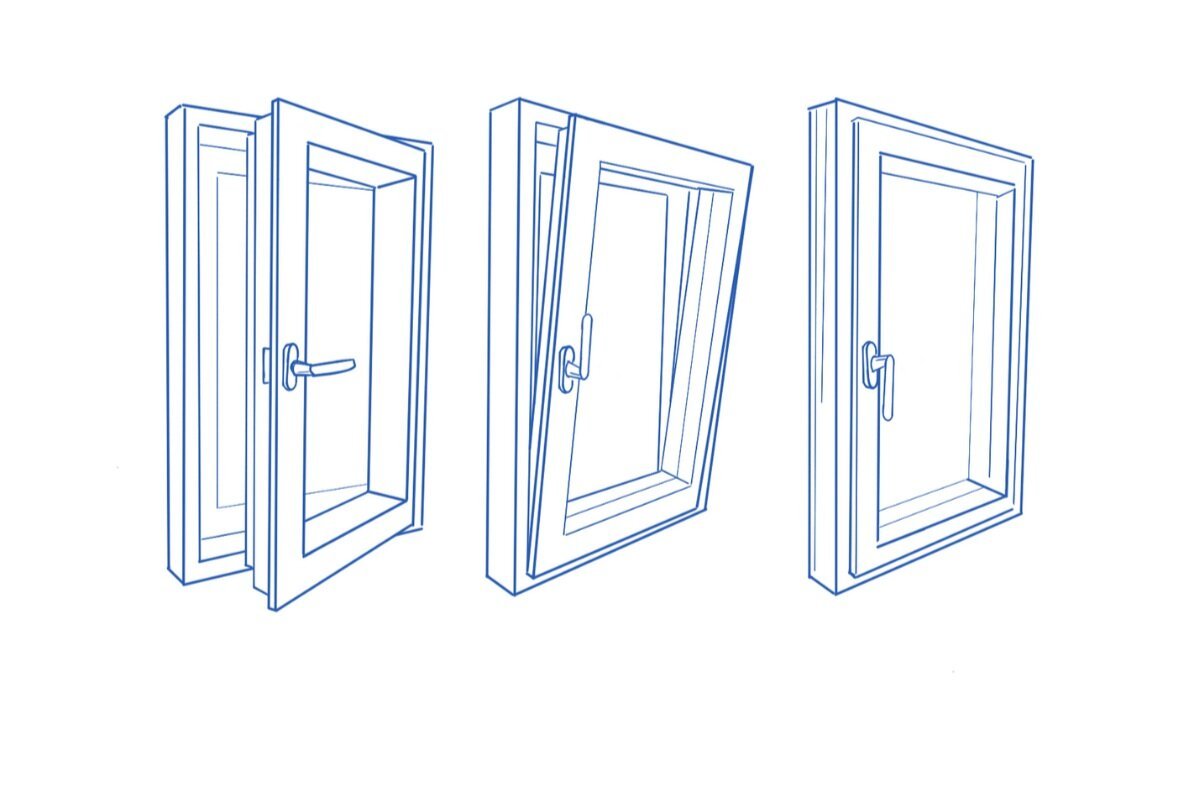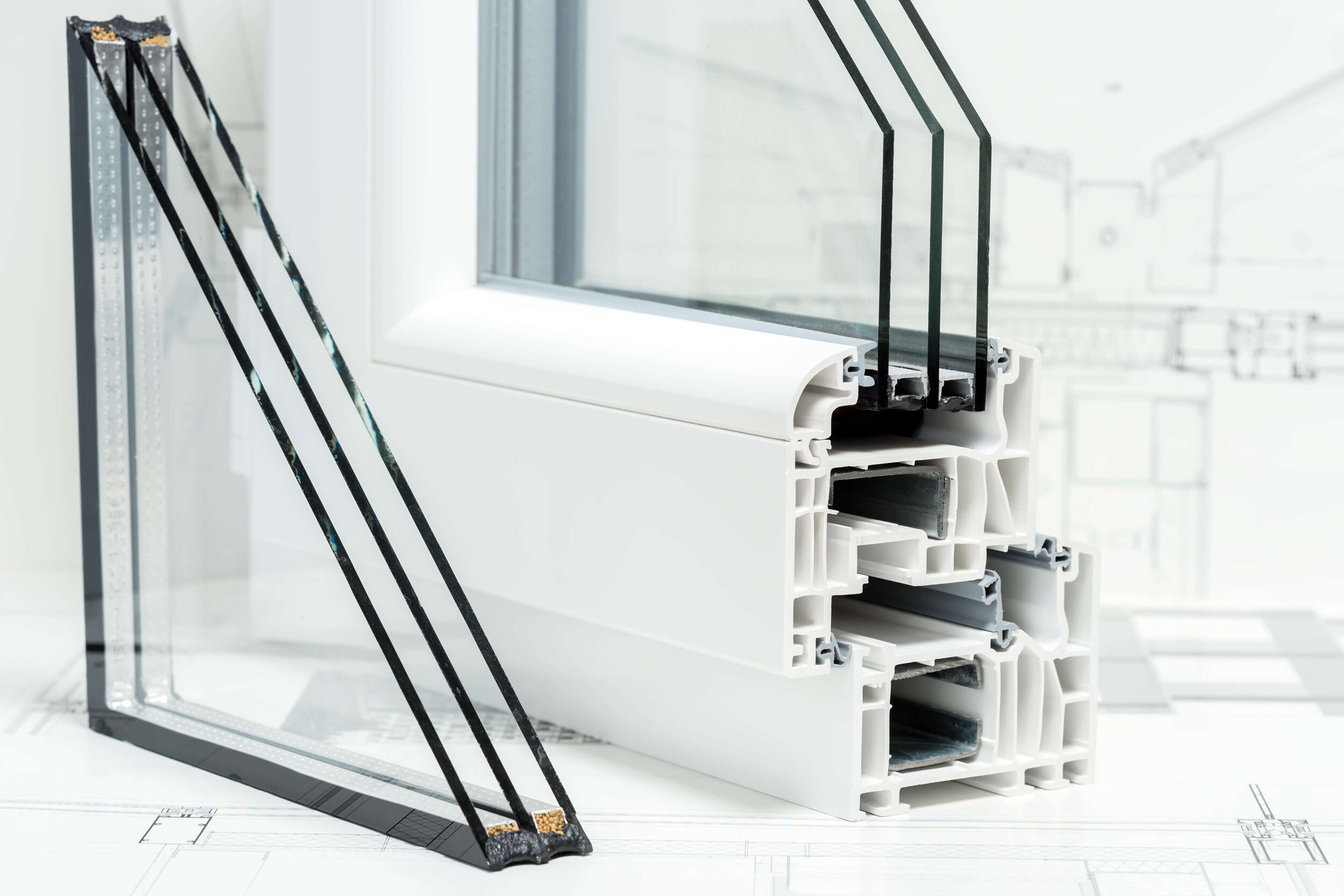What are European Windows and Doors?
The term “European windows and doors” is a catch-all term that refers to windows and doors that originate in Europe and share a variety of design characteristics.
These characteristics usually include:
Unique functionalities like “tilt and turn” for windows and “lift and slide” for doors.
Performance aspects such as high-end thermal efficiency, sound proofing and forced entry resistance.
Design features like modern lines, slim profile face widths, and custom sizing and coloring options.
Due to the German origin of their design, European windows and doors are sometimes also called German windows and doors. German windows and doors became the de facto standard in Europe, and the terms are now used interchangeably.
Check out this article of you want to learn more about the history!
In this article, we’ll provide an overview of the characteristics that make European windows and doors distinct, and we’ll explain them in depth so you are ready to engage with industry professionals and ask the right questions.
Let’s get started with the first group of defining characteristics: functionalities.
What are the unique functionalities of European Windows and Doors?
While European window and door systems usually offer a full range of product functionalities, there are two that stand out as special and unique:
Tilt and turn functionality for windows and patio doors.
Lift and slide functionality for sliding doors.
Learn more about European window and door functionalities below, or keep scrolling to the next section to explore European window performance and design features.
Tilt and Turn Functionality
With tilt and turn windows and patio doors you are able to open the vent inwards just like a door and also tilt the vent by 10 to 15 degrees for easy ventilation. They work by the simple turning of a single handle. Watch the video below to see a tilt and turn window in action!
How does a tilt and turn window work?
There are three different positions for the handle:
When the handle is pointing downward, the window is closed, and at least five steel locking pins are engaged around the vent, keeping the window securely shut.
When the handle is turned by 90 degrees into the horizontal position, the window functions much like a normal door. In this position, the locking pins are disengaged, and the window vent can swing inwards. The vent is supported by two hinges on the same side of the vent, one at the top corner and one at the bottom corner, similar to a regular door.
Tilt and turn window can turn open like a door and tilt for secure ventilation.
Only when the handle is turned by another 90 degrees, pointing upwards now, the window starts operating differently than a door. A hinge at the bottom corner of the vent is engaged, while the hinge at the upper corner is disengaged. The vent suddenly tilts inwards, held by the hinges at the bottom corners and a hidden stay at the top. That is possible because of an ingenious design: One of the hinges on the lower corner operates in two directions, supporting both the tilt function and the turn function. The other two hinges operate in only one direction, supporting either the tilt operation or the turn operation, depending on the position of the handle.
In this way, the whole window can open like a door or just tilt inward by 10 to 15 degrees, allowing easy ventilation while protecting against intruders or weather changes. Learn more about tilt and turn in this in-depth article.
Read to explore pricing for European tilt-and-turn windows? You can do that here.
Lift and Slide Functionality
Lift and slide doors can be opened with the push of a finger thanks to their special sliding mechanism.
Doors with lift and slide functionality represent a significant upgrade compared to domestic slider doors. While both doors operate by sliding a glass panel to one side or the other, the two types of doors are equipped with completely different sliding mechanisms and sealing strategies. Domestic slider doors use bottom-mounted wheels that roll along a rail integrated into the threshold of the door frame. With this design, the seals are permanently engaged, so the seals are always fighting against the movement of the panel when it is being opened or closed.
The lift and slide doors, however, avoid this physical struggle of opening and closing, as well as other issues, by moving the sliding mechanism to the top of the frame and engaging it only when needed. As you turn the handle down, the vent is lifted by a pulley system. Now, the vent hovers off the bottom of the frame, disengaging the seals all the way around the vent. In the top of the frame, the vent sits on rollers in a rail that has been lifted up by the pulley system. As the rail is protected from debris and corrosion and the vent has sufficient clearance, the door now slides at the push of a finger. Move the handle back in the original position and the rail is lowered, sitting the vent back down on the bottom of the frame for maximum air and water tightness. Learn more about it here!
What are unique performance aspects of European Windows and Doors?
Cross section of a European window with thermally broken PVC profile and triple glazing.
As their design originated in the cold climate of Germany, thermal efficiency is a key performance aspect of European windows and doors. It’s achieved by combining multiple design innovations. Here are three that you should know about:
European window profiles are thermally broken. Whether it’s aluminum, steel or PVC, the material on the exterior of the window is separated from the interior of the window by air chambers and thermally broken connecting materials. Sometimes, these air chambers are partially or completely filled by foam for added insulation. All of these chambers and materials constitute the window’s thermal break, minimizing the transmission of thermal energy between the interior and exterior of the window.
European windows are designed for triple glazing. Beside the window’s profile, its glazing is the other component that determines its thermal efficiency. By leaving extra space for the glazing package, European windows and doors can be easily equipped with high-performance triple glazing. By using three panes of glass and filling the space between the panes with insulating gas, the thermal efficiency is significantly better than standard double glazing.
European windows offer higher performance seals. Due to the different design of the opening mechanisms, European windows can house more efficient seals between the vent and the frame. As the vent isn’t sliding through these seals like on a double hung window, there is also significantly less wear and tear.
In addition to inhibiting thermal energy transmittance, these three innovations boost the window’s sound dampening properties, making exceptional sound performance another key performance aspect of European windows and doors.
Next on the list is forced entry resistance. Tilt and turn windows have at least five hardened, metal locking pins or bolts installed around the perimeter of the vent. When the handle is moved into the ‘closed’ position (pointing down), the bolt heads slide into steel pockets integrated in the frame, pulling the vent tightly shut. This mechanism, protected between the vent and the frame, provides outstanding forced entry resistance, outperforming any standard double hung or casement window.
The design of the locking mechanism also helps with waterproofing. By sliding the bolt heads into the pockets, the vent connects with the frame in the optimal position, assuring maximum performance and longevity of the seals. With this design, leaking almost never occurs on tilt and turn windows.
Finally, the metal construction of the window hardware, its positioning between vent and frame and its low wear operation through a single lever assures a very durable window mechanism.
What are the unique aesthetic design features of European Windows and Doors?
Selection of color options for a European aluminum window.
This question is a little more difficult. While most people might have a certain look in mind when they think of European windows and doors, the aesthetic design options are actually quite broad. This is because Europe has a huge variety of building styles, and the windows and doors need to match everything from historic buildings to high-end modern designs. However, three aspects stand out about the visual design of European windows and doors:
Modern designs are more popular in Europe than in other markets. As they’re making up a big chunk of the market, European manufacturers are focusing their efforts to create product innovations on modern design options. As a result, modern design features like minimal face widths on thermally broken window and door profiles are much more broadly available in Europe than anywhere else.
In order to cater to the broad range of design tastes across continental Europe, European suppliers have integrated flexible, custom design options into their manufacturing process. Therefore, a wide range of color and surface finish options are standard design features of European windows and doors.
The more robust and stable designs of the window and door profiles make oversized configurations less of an issue, and in turn, European windows and doors are often associated with big assemblies and larger glazing panes.
Do you have questions about European windows and doors that we haven’t answered? Leave us a note below! You can also browse brands and products here.
What about European Windows vs. American Windows?
European windows are significantly different from the average American windows in all of the above categories: functionality, performance, and design.
Functionality: American windows are typically what’s referred to as “double hung.” That is, there are two panes that slide over one another. In most cases, the bottom section slides up over the top section. Other popular configurations of American windows are sliding and crank-out casement windows.
Performance: European windows outperform the average American window on thermal efficiency, sound proofing, waterproofing, and security.
Design: The average American windows is not particularly modern. They also typically come in standard colors, like whites, off-whites, and may have grids that intersect across the glazing. European windows, on the other hand, often feature larger glazing sections and more minimalistic grids (if there are grids at all).
Where can you buy European Windows in the USA?
There are a variety of places you can purchase European windows in the USA. While we won’t be naming competitors here, we do want to highlight a few distinctions: some companies manufacture European-style windows here in America. Others import European windows and doors from Europe to the US. There are pros and cons to each approach.
When you buy a US-manufactured product, you’ll deal with some conveniences (like local sourcing and shipping), but you’ll pay a premium for American manufacturing. There may also be quality and performance differences, so make sure you’re truly comparing apples to apples.
On the other hand, sourcing directly from Europe often yields both incredibly high performance and lower prices for you. However, you will have to deal with international shipping and customs, which can mean longer lead times.
Bauwerk sources our European windows and doors directly from the highest quality manufacturing partners and brands in Europe, including Schüco, Reynaers, and Jansen, and we deliver directly to your building site.
Now you know what makes European Windows and Doors uniquely suited for modern building projects. To explore European windows for your next project, get a quote here:
Get a Quote for European Windows & Doors
Editors note: this blog was originally published in 2020, but has been updated and edited in 2022.
About Bauwerk Building Solutions
Bauwerk is a multinational business that connects US clients to an extensive network of European manufacturers of windows, doors, curtain wall systems, and more. We specialize in innovative and refined building products of the highest quality. Our offices are located in Charlotte, NC and Berlin, Germany.




